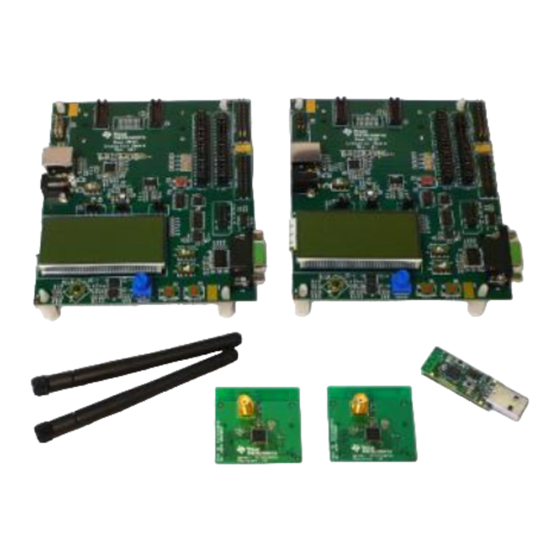
Advertisement
Quick Links
CC2530DK Quick Start Guide
1. Kit Contents
2 x CC2530EM
2 x Pulse W1010 2.4 GHz antennas
2 x SmartRF05EB
1 x CC2531 USB Dongle (sniffer)
Documentation
The RF boards in this kit are FCC and IC certified
and tested. The antenna, W1010 from Pulse, is a
¼ wave dipole antenna with 2 dBi gain.
4. Select Power Source
Locate
the
power source
header
P11
just above the
LCD
on
the
SmartRF05EB
Connect pins 1 and 2 if you are using
batteries to power the board. Connect pins
2 and 3 if you are using USB or external
power supply.
Once you have
set P11, find
switch P8 just
next to the DC
jack
on
the
SmartRF05EB.
To
power
on
the board, flip the switch from "OFF" to
"ON".
7. Set up the Receiver
Set one of the boards to operate as
receiver. Use the joystick to select mode.
Confirm by pressing Button 1.
The receiver will now wait for packets
from the transmitter.
1
When using an external power supply, make sure it meets the listed requirements in addition to complying with applicable regional
product regulatory and safety certification requirements such as UL, CSA, VDE, CCC, and PSE.
2. Running the PER Test
The CC2530 device in this kit comes
preprogrammed with a packet error rate
test. This Quick Start Guide will explain
how to run the test and what to do next.
Start by plugging the CC2530EM with
antenna into the SmartRF05EB [4] as
shown below.
Note that the PCB antenna on the board
is not enabled by default.
FCC/IC Regulatory Compliance
FCC Part 15 Class A Compliant
IC ICES-003 Class A Compliant
5. Packet Error Rate (PER)
When
power
is
applied
SmartRF05EB, the preprogrammed PER
test on the CC2530 will start running.
The LCD will display the screen as shown
in the picture above. The number in the
parentheses is the revision of the CC2530.
Press
Button
1
(S1) to continue.
8. Set up the Transmitter
Set the other board to operate as
transmitter. Use the joystick to select
mode. Confirm the selection by pressing
Button 1.
On
the
transmitter
node,
parameters have to be set. On the next
screen, select the TX output power (signal
strength). Use the joystick to select
between -3 dBm, 0 dBm or 4 dBm.
Confirm the selection with Button 1.
3. Power Options
There are several ways of applying power
to the SmartRF05EB;
USB (5V through USB plug)
External Power Supply
(requirements below)
2 x 1.5V AA Non-Rechargeable Alkaline
Batteries
Voltage regulators on the SmartRF05EB
will set the on-board voltage to 3.3V.
External Power Supply
Nom Voltage: 4 to 20 VDC
Max Current: 1500 mA
Efficiency Level V
Warning! To minimize risk of personal
injury or property damage, never use
rechargeable batteries to power the board.
Do not leave the board powered when
unattended.
6. Select Channel
to
the
Select one of the 16 IEEE 802.15.4
channels, with channel number from 11 to
26 (2405-2480 MHz, 5 MHz channel
spacing). Select the same channel for both
boards.
The channel is selected by moving the
joystick to the right or left.
Press Button 1 to confirm the selection.
9. TX: Packets and Rate
Next, select burst size (number of packets to
send) by using the joystick, either 1000, 10K,
100K or 1M packets. Confirm the selection with
Button 1.
additional
After selecting burst size, select packet rate;
100, 50, 20 or 10 packet per second. Confirm
the selection with Button 1.
SWRA273C
January 2015
1
Requirements:
Advertisement

Summary of Contents for Texas Instruments CC2530DK
- Page 1 SWRA273C January 2015 CC2530DK Quick Start Guide 1. Kit Contents 2. Running the PER Test 3. Power Options The CC2530 device in this kit comes There are several ways of applying power preprogrammed with a packet error rate to the SmartRF05EB;...
- Page 2 13. Flash Programmer 14. IAR Embedded Workbench 15. Packet Sniffer Texas Instruments has a simple tool To develop software, program and debug In order to debug RF protocols, it is possible to use TI’s SmartRF Packet Sniffer. which can be used to program the flash...
- Page 3 IMPORTANT NOTICE Texas Instruments Incorporated and its subsidiaries (TI) reserve the right to make corrections, enhancements, improvements and other changes to its semiconductor products and services per JESD46, latest issue, and to discontinue any product or service per JESD48, latest issue.















Need help?
Do you have a question about the CC2530DK and is the answer not in the manual?
Questions and answers